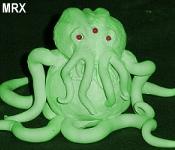At this year's Origins Game Fair (June 22-26, 2011) I am running a lovecraftian Live Action Role Playing game based on one I ran last year called "The Space Between". Last year's LARP was basically the prequel to the movie "Event Horizon". The maiden voyage of an experimental spaceship that can travel across the galaxy by punching a hole through space and entering another dimension. This year's LARP, called "Æthernauts", is a reboot of that story, but reworked in a Victorian steampunk setting. To that end, I have a whole slate of steampunk props that I am working on for the game. I don't want to give away any spoilers about the game, but I do want to share the props with you. They are all works in progress at the moment, so I will be posting their construction piecemeal.
This is the first item for Æthernauts that I started on. It is going to be a steampunk phonograph. It was originally just going to be a prop of a regular phonograph, but during the brainstorming, I had the idea to replace the needle with a laser pointer, kind of making it a Victorian CD player.
Using a disk rather than a cylinder would have been much easier. I could have just bought any old vinyl record and made a new label. But I have never been one to take the easy road. I preferred a cylinder, so that's where I started. I had an idea of what might look good, but it was untested, so I had no idea how it would turn out.
I'm on a very tight budget for this project, so the cylinders have their inglorious origins in my bathroom waste bin. These toilet paper rolls needed a little reinforcement, and a way to hide the tell tale spiral seam that makes them look like, well... toilet paper rolls. So I wrapped them in some office paper trimmed to size and coated in glue. Then I gave them a base coat of black spray paint.
Next came the grooves. Making grooves or indentations into the rolls would have been hard, but creating raised ridges is quite easy. A little Mod Podge, a healthy length of black crochet thread, and a lot of patience. It's important to make sure that the windings are evenly spaced and have no crossed windings.
Once the Mod Podge was dry, I gave it another shot of gloss black spray paint. The raised thread looked a little wrong, but luckily I had an idea how I could make it right. I made a strip of paper the width of the space with no windings, and wrapped and glued it to each end of the cylinder. This raised the surface of the cylinder to match the height of the windings, making the grooves below the surface, just like they should be. Another shot of gloss black and viola! (yes, I know. it's a thing)
Being pleased with the results I set about gilding the lily. A custom made cylinder box seemed the thing to do. I based the design on the old player piano scroll boxes we used to have when I was a kid. Antiques even back then. I had never made a box with a fitted lid from scratch, and I was a little concerned that the tolerances would be too tight for me to pull off (exact measurements have never been my strongest suit), but it didn't turn out too bad.
I plan to make some printed paper labels for the boxes, but I haven't designed them yet. I did do a little recon to see what actual cylinder packaging of the period looked like, but I actually don't like it, and it's the wrong shape, so I think I'll make some labels reminiscent of the ones on those old piano scrolls.
It might be worth mentioning that before looking up the packaging designs on wikipedia, (which was after I made the prop cylinders) I had never seen an actual wax phonograph cylinder. Of course I had a vague idea what they should look like, but I had never seen a close up picture. They are a lot thicker that I thought. Anyway, I guess most of my players probably haven't seen one up close either. Here's to hoping.
Next up will be work on the body of the phonograph and the speaker horn. I have selected a prefab box to use as the body. I'm going with the rectangular one, on the right. I like the baroque scroll work on the lid. It will serve as a nice speaker grill for the real speakers that will be hidden inside.
More on that later.
See Also:
Steampunk Phonograph (pt. 2)
Steampunk Phonograph (pt. 3)
Steampunk Phonograph (pt. 4)
Phonograph Prop Redux
Great Cthulhu
-
This Cthulhu bust in oxidized copper comes to us from Lithuanian artists By
MU. The sculpt features some fantastic texture work. I believe this is
the ...
2 days ago
























No comments:
Post a Comment